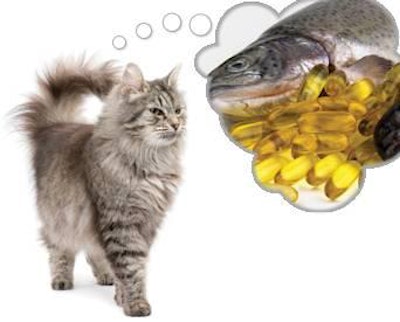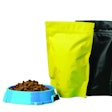
Omega-3 fatty acids are proven to have numerous health benefits for pets, just like they do for humans. Numerous clinical studies have proven the health benefits of the long chain omega-3 fatty acids EPA and DHA, vital components in every cell membrane supporting cell survival, growth, renewal and other critical functions. Health-promoting effects of EPA and DHA are found in several vital organs, including the heart, kidney, liver, joints, brain, eyes and skin, and are beneficial to maintaining a healthy coat, according to Aker BioMarine, producers of Qrill Pet, an omega-3 supplement derived from krill.
According to BioMarine 's research, compared to healthy subjects, animals who are overweight and obese have an increased level of signaling molecules (endocannabinoids) that influence appetite and emotional state. Krill phopsholipid omega-3s have been shown to decrease the level of these signaling molecules. This can have a positive effect in the regulation of food intake in obese animals, says the company.
The omega-3 fatty acids in Qrill Pet are mainly in phospholipid form. The omega-3s in most petfoods are primarily derived from oily fish, providing omega-3s in triglyceride form. Phospholipid omega-3s are the building blocks of cell membranes and have a higher uptake into the cell membranes, according to BioMarine. Being water dispersible makes them gentler on the pet's stomach and more readily absorbed by the body. Elevated concentrations of omega-3s in vital organs, such as the brain, eyes and liver, are observed when delivered as omega-3 phospholipids compared to omega-3 triglycerides.
There are several types of omega-3 fatty acids. Two crucial ones—EPA and DHA—are primarily found in certain oily fish, such as salmon. Plants like flax contain ALA, an omega-3 fatty acid that is partially converted into DHA and EPA in the human body. Algae oil often provides only DHA. According to petMD.com, DHA and EPA—from fish and fish oil—have better-established health benefits than ALA. Although people can convert ALA into DHA (and EPA, or eicosapentaenoic acid) the ability of dogs to do this appears limited, says Dr. Jennifer Coates, DVM.
A paper published in the September 1, 2012, issue of the Journal of the American Veterinary Medical Association looked into whether or not foods containing high levels of DHA improved puppies’ cognitive, memory, psychomotor, immunologic and retinal function when fed after weaning (S.C. Zicker et al., 2012). Previous studies had revealed that feeding DHA-rich foods to pregnant females during gestation and lactation and to puppies prior to weaning improved puppies’ retinal activity and "trainability," but this particular research investigated whether or not supplementing the diets of older puppies could have similar benefits. This is a relevant question because most pet owners obtain their puppies after weaning and therefore have little control over their DHA intake before this time.
The researchers fed female beagles a food that was adequate for gestation and lactation but contained low levels of DHA for two weeks or more prior to conception and through pregnancy and lactation. After weaning, 48 puppies were divided equally into one of three groups that ate either a low, moderate or high DHA food until they were one year old. The high DHA food also contained more vitamin E, taurine, choline and L-carnitine, but the study’s results certainly point to a potential benefit in supplementing puppies’ diets with DHA after weaning.
The researchers found that "Dietary fortification with fish oils rich in DHA and possibly other nutrients implicated in neurocognitive development following weaning improved cognitive, memory, psychomotor, immunologic and retinal functions in growing dogs." Specifically, the high-DHA group of puppies had better results “for reversal task learning, visual contrast discrimination and early psychomotor performance in side-to-side navigation through an obstacle-containing maze than did the moderate-DHA and low-DHA groups."
In another study published in Japan Online in July 2012 (M. Moreau et al., 2012), the effects of feeding a high omega-3 fatty acids diet in dogs with naturally occurring osteoarthritis were studied and researchers concluded a veterinary therapeutic diet with high levels of omega-3 from fish improved locomotor disability and performance in the dogs' daily activities. Such a nutritional approach appears interesting for managing osteoarthritis in dogs.
According to research done on supplementation with omega-3 fatty acids in cats' diets, the addition of EPA changes the owner’s perception of aspects of behavior and locomotion in cats with naturally occurring osteoarthritis, as well (R.J. Corbee et al., 2012). Cats on the fish oil in the study revealed higher activity level, more walking up and down the stairs, less stiffness during gait, more interaction with the owner and higher jumps compared to those on corn oil supplementation.















